
 Thw Archives
The Hockey Writers
Thw Archives
The Hockey Writers
105
Reads
0
Comments
An Interview with Bobby Smith
Originally written back in 2012, this chat with one of the game’s greats will be a very nice trip down memory lane for some of our older readers – we also hope younger ones will appreciate how good and how much of a gentleman Bobby Smith was (and still is).
The 1977-78 season for the Minnesota North Stars was hockey atrocity. Three coaches, 18 wins, and 53 losses. That kind of futility earned the franchise its first #1 overall pick in the draft, and 1978 was a consensus year, where there is no debate over who goes first: Minnesota chose Ottawa 67’s centerman Bobby Smith.
“[Smith] is an excellent skater who has the agility and coordination of a smaller man … has exceptional hockey sense … is a level-headed individual with tremendous potential.” — NHL Central Scouting (1978)
Born in remote North Sydney, Nova Scotia, Smith grew up in Ottawa. He joined the 67’s in 1975 and played three years in the Ontario Hockey League, with his third and final year regarded as the greatest offensive season in the history of the league: in 61 games, Smith scored 69-123-192 points; assists and points totals that remain tops in the OHL record books today.
He won the Red Tilson Award as the league’s Most Outstanding Player, the Eddie Powers Memorial Trophy as the league’s top scorer (Sault Ste Marie rookie Wayne Gretzky came in second with 182 points), and he was named the Canadian Hockey League Player of the Year.
“Unassuming and unpretentious, if you could pick your own son, you would pick somebody like Bob Smith.”
— Ottawa 67’s coach Brian Kilrea (1978)
Thus the 6’4″ 210 lb centerman joined the worst team in the NHL and he didn’t skip a beat. Smith scored 30-44-74 in 80 games, good enough for the Calder Trophy as Rookie of the Year. For their second pick in the 1978 draft, the North Stars wisely took Smith’s left winger in Ottawa, Steve Payne. Along with winger Al MacAdam, the three made up the North Stars’ most potent offensive line of the era, and Smith and Payne remain close to this day.
In the 1981-82 season, Smith scored 43-71-114 in 80 games, a total that still stands as the best offensive season in the 44 year history of the franchise. That summer, the North Stars signed Smith to a seven year contract–the longest in team history at the time. Fifteen months later, they traded him to the Montreal Canadiens, where he spent the next seven years before being reacquired by Minnesota for the last three years of a 15 year career.
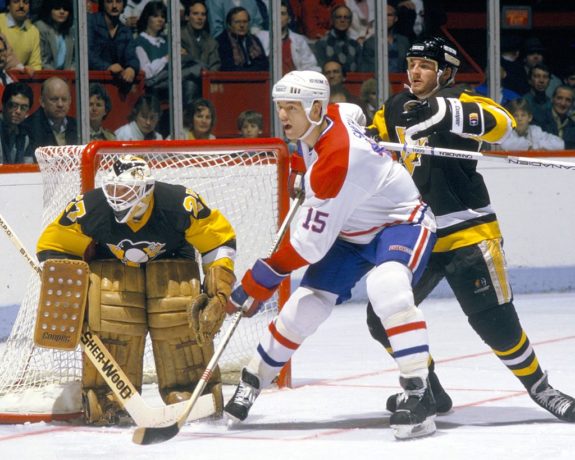
“With his size, [Smith] can reach across what looks like half the rink.” — Jim Roberts
In 1996, Smith was named the first GM of the Pheonix Coyotes, guiding the team to a 151-134-39-4 record and four straight playoff appearances. In February of 2001, Wayne Gretzky became the team’s majority owner and relieved Smith of his role.
“Smith appears to have the attributes of the All-Canadian Boy.” –North Stars scouting report
Today, Bobby Smith is the majority owner of the Halifax Mooseheads of the Quebec Major Junior Hockey League. As he begins his second decade in ownership, Smith was kind enough to permit me to interview him about his life in hockey.
The newspaper clippings found throughout the interview come from the scrapbooks I made as a seven year old: Bobby Smith, you see, was my childhood hockey hero. Back then, a kid was assured just one image of his favorite player every year–on his hockey card. So when Smith appeared in the papers, I kept it–even if it portrayed him getting punched in the head or “skating glumly by”. For professional reasons, I withheld this information until the very end of the interview, and for the same reason I have omitted it below.
Bonander: I remember when the North Stars traded you to Montreal. I was upset but also glad, because I thought ‘Well at least he’s got a shot at winning a Cup.’ Granted you had a shot in 1981 against the Islanders but—
Smith: But it was not a very realistic shot.
In 1986 with the Canadians, I remember we checked into a hotel two nights before the Series started even though we had home ice advantage, and the coach went around the room and asked guys to say a few words, and we had quite a few guys who had won a Cup before, and at the end I said “I’d like to say something: I’m the only guy in here who’s been to the Finals who didn’t win. We gotta play this like this is our last chance, because there’s a really good chance it is gonna be our last chance.”
As crazy as it sounds, I don’t think we had that kind of desperation in Minnesota. We figured ‘Hey, all our best players are young, if we don’t win it this year we’ll be back next year, and the Islanders are a little bit better than us so we’re [just] happy to be here.’ Well boom, it was over before you knew it.
That Montreal team was a mixed bag. On one end you had Bob Gainey and Larry Robinson.
And the other end, we had eight rookies—rookies who played incredible hockey. Patrick Roy’s rookie year. Claude Lemieux, who played most of the season in the minors, then scored 10 goals for us in the playoffs.
Claude Lemieux has his detractors, of course, but Mike Peluso has talked about how much he hated Lemieux until Lemieux was traded to New Jersey while he was there. He says, “and we all just fell in love with him. What a great guy. Best teammate ever.”
Claude and I are still friends. I think I was 28 and he was 20 when we played on a line together. He is a tremendously competitive person, but off the ice he is the opposite of all expectations. A complete gentleman, fun to be around, and you know, I’d gladly take a couple Claude Lemieux’s on the Halifax Mooseheads any day.
In 2003 you told Hockey Digest that your most memorable game was when you scored the Cup clinching goal for Montreal in 1986. How about your most memorable game as a North Star?
Well one night everything went well for me in Minnesota and I ended up getting four goals and three assists, but to be fair I didn’t play particularly well, everything just went my way. So the most memorable North Stars game for me would definitely be the Semifinal clinching game against Calgary, when we beat the Flames and were going on to the Stanley Cup.
I can remember being on the bench late in the game and I think Brad Palmer scored to open up a big lead and there were only a few minutes left and I was just jumping up and down thinking ‘We’re going to the Finals!’ It’s a cliché from a thousand different players—you grow up on the outdoor rink pretending you’re in the Stanley Cup Finals, you play on the driveway pretending you’re in the Stanley Cup Finals, and here we were, actually going to the Stanley Cup Finals. And I remember that as clear as anything.
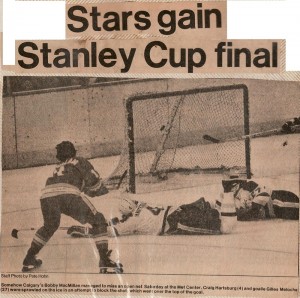
In that series, Flames goalie Pat Riggin said “If we can shut down Bobby Smith, we shut down their offense,” but they only achieved that once in six games. Otherwise, you had back-to-back four-point games against Calgary.
I played well in that series. But it was a difficult playoff for me that year because my mother died during the second round of the playoffs, after a long bout with cancer. For a 23 year old guy it was a pretty emotional time. I remember I actually played a game the day that she died. My mom and dad had talked about it beforehand and said, ‘Hey, when this happens, he’s got a responsibility to his team.’ But as you can imagine I was not very good on the ice that night. Fortunately my best buddy Steve Payne scored two goals to ensure we beat Buffalo.
[NB: In game one of that series, Payne scored in the third period and again in overtime to give Minnesota a 4-3 win. They would take the series 4-1.]
Not much of an organized support system in place back then I imagine.
You can’t compare then to today. For example, when I was in Juniors, we had a coach on the bus and a trainer on the bus. And the trainer was both the equipment guy and the medic, and he had no medical education at all. On the Mooseheads, we have a general manager, a coach, two full time assistant coaches, a goalie coach, a certified medical trainer, an equipment man, a strengthening and conditioning coach, an educational adviser, and a sports psychologist. We run a more sophisticated organization than the North Stars were in 1978. That’s no knock on Minnesota, it’s an indication of how much things have changed.
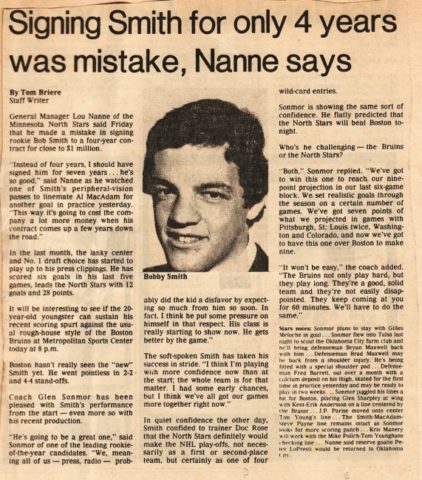
We hear often nowadays about young players having agents but there was a time when guys would get to the draft without any representation. Coming into the 1978 amateur draft, did you have an agent?
I did. The WHA was still in existence, so between the NHL and the WHA, my last year in Junior I was 19 I said listen the phone’s ringing all the time, I gotta get an agent, so I hired a lawyer out of Montreal named Norm Caplan.
Trying to maintain my position at the head of the draft, trying to finish ahead of a 16 year old kid named Wayne Gretzky in the scoring race, it just made sense. We have the kids now at 16 showing up at training camp and they all have agents.
[NB: Norm Caplan and Alan Eagleson were the two biggest agents of the 1970s. Caplan represented over 200 players including Smith, Bernie Federko, Guy Lafleur, Mats Naslund, Mark Messier, and Rod Langway in a career that was cut tragically short in 1984 by a heart attack when he was just 40 years old.]
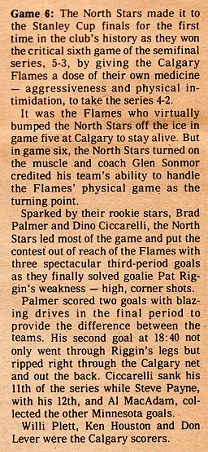
Since you were clearly going very high, do you think you were one of the few guys in the draft with an agent?
Oh no. No. Most everyone had one.
And it wasn’t just Alan Eagleson.
No. There was Eagleson’s group, Caplan and those guys out of Montreal—there was a bunch of them by then.
You spent about ten years involved with the Players’ Association.
Was it that long? I’m not sure how long I was involved. We had a president, and there were I think two vice presidents from each division so there were eight of us, and each team had a player representative. But back then the Player’s Association was another organization that was not as sophisticated then as it is now. It was run out of Alan Eagleson‘s law office, he divided his time between his law practice and being head of the Player’s Association. It was not nearly the enterprise that it is now.
In 1993 you retired, age 35, and did something that almost nobody in your shoes does: you went to college.
Right.
University of Minnesota.
Exactly. Over the years in the NHL I had picked up some credits here and there in the off-season, so I was able to earn a Bachelor’s [Business] and a Master’s [MBA] in about three years. This was ’93, so my kids were 4, 6 and 8, it was a really enjoyable time, and very valuable. They were three great family years: as a student you make your own schedule, so I’d come home from school and if it was twenty degrees and sunny there’d be no studying that day, we’d gather the kids and go to the outdoor rink for three hours and have a blast. I just had to study twice as hard the next day.
That’s not something you hear that often.
No, and it’s part of my pitch to Junior players. Those universities are gonna be there for a long time. The way I view it is, a teenager—this is what I did myself and what I counselled my own son to do–you have two really important things to accomplish in the next few years: one is to find out if you can be an NHL player, and the other is to get an education, and I don’t know why you’d want to try and juggle both at the same time.
I grew up in a household where my parents were children during the Depression, and their five kids were going to get an education if it killed them. My mother was not happy when I was becoming a hockey player, she had other plans for me. I think part of it too was I never wanted to hear my kids say ‘If an education is so important how come you never got one?’
[NB: According to North Stars scouting documents, Smith began taking classes at Ottawa University while still in Juniors. Following his final year, the OHL established the Bobby Smith Trophy, which honors the OHL Scholastic Player of the Year who best combines high standards of play and academic excellence. Past winners include Manny Malholtra, Steven Stamkos, Ryan Ellis, and the only three-time winner, Dustin Brown.]
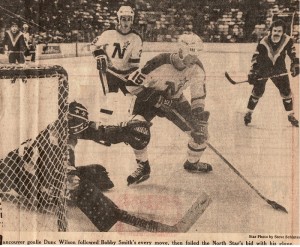
You were involved with the Player’s Association, you were a GM, and now you’re in ownership. Do you have any thoughts on the current CBA negotiations?
I just read the articles as they come up, only as a fan. It’s been years since I was an NHL GM so I think I see it the same way as most people who follow it do–Hey, $3.3 billion worth of revenue, they should be able to figure out a way to divide it up.
So what’s next for you?
I’m really happy where I am. I love being involved with Junior hockey. Major Juniors is such a great Canadian institution. I can remember watching Junior hockey as a kid and you had to go down when the London Knights came because they had this guy we’d all heard so much about by the name of Darryl Sittler. And then Montreal [Jr Canadiens] would be coming in, and you gotta go see this kid named Gilbert Perreault.
And Junior hockey still has that excitement. There’s bigger gaps in Junior hockey between the best guy and the worst guy on the ice compared to the NHL, and it gives the best guy a bit more of an opportunity to strut his stuff.
You can go to an NHL game and the biggest star in the game may not get a shot on net. You can watch the Halifax Mooseheads play and I’ll tell you what, our best player’s going to go end-to-end two or three times and bring you out of your seat.
VIDEOS
[The greatness of YouTube: The complete Game 7 of the 1980 Quarterfinals between Montreal and Minnesota at the fabled Forum, as called by the legendary Danny Gallivan. Tied 2-2 with less than two minutes to go, Smith chased a loose puck down the left side and centered it. Payne got a piece of it and Al MacAdam buried it, ending Montreal’s bid for a fifth straight Stanley Cup.]
[Here, Smith’s third period wrist shot from 25 feet out beats Mike Vernon and proves to be the Cup clincher for Montreal in ’86.]
Written by Ross Bonander back in 2012.
The post An Interview with Bobby Smith appeared first on The Hockey Writers.
Popular Articles

















































 Canucks Vancouver
Canucks Vancouver Sharks San Jose
Sharks San Jose Flames Calgary
Flames Calgary Avalanche Colorado
Avalanche Colorado Coyotes Arizona
Coyotes Arizona Golden Knights Vegas
Golden Knights Vegas Wild Minnesota
Wild Minnesota Red Wings Detroit
Red Wings Detroit Blues St. Louis
Blues St. Louis Blackhawks Chicago
Blackhawks Chicago Blue Jackets Columbus
Blue Jackets Columbus Hurricanes Carolina
Hurricanes Carolina Jets Winnipeg
Jets Winnipeg Predators Nashville
Predators Nashville Ducks Anaheim
Ducks Anaheim Oilers Edmonton
Oilers Edmonton Sabres Buffalo
Sabres Buffalo Rangers New York
Rangers New York Bruins Boston
Bruins Boston Panthers Florida
Panthers Florida Senators Ottawa
Senators Ottawa Lightning Tampa Bay
Lightning Tampa Bay Capitals Washington
Capitals Washington Islanders New York
Islanders New York Devils New Jersey
Devils New Jersey Maple Leafs Toronto
Maple Leafs Toronto Flyers Philadelphia
Flyers Philadelphia Penguins Pittsburgh
Penguins Pittsburgh Stars Dallas
Stars Dallas Kraken Seattle
Kraken Seattle Kings Los Angeles
Kings Los Angeles






